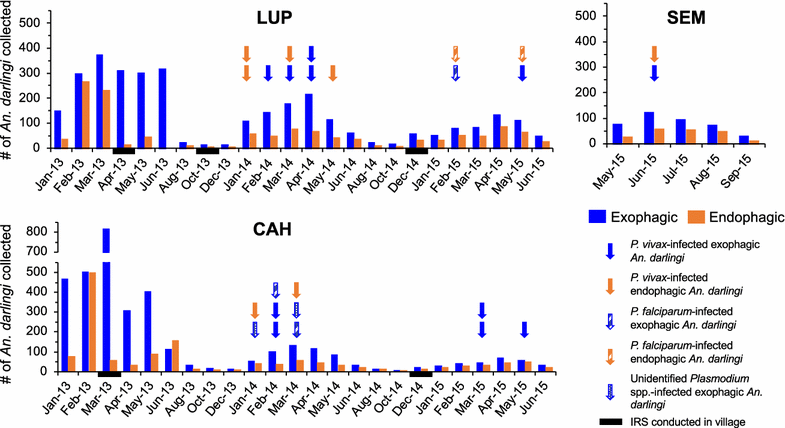Decreasing proportion of Anopheles darlingi biting outdoors between long-lasting insecticidal net distributions in peri-Iquitos, Amazonian Peru
- PMID: 29463241
- PMCID: PMC5819687
- DOI: 10.1186/s12936-018-2234-4
Decreasing proportion of Anopheles darlingi biting outdoors between long-lasting insecticidal net distributions in peri-Iquitos, Amazonian Peru
Abstract
Background: In Loreto Department, Peru, a successful 2005-2010 malaria control programme (known as PAMAFRO) included massive distribution of long-lasting insecticidal nets (LLINs). Additional local distribution of LLINs occurred in individual villages, but not between 2012 and 2015. A 2011-2012 study of the primary regional malaria vector Anopheles darlingi detected a trend of increased exophagy compared with pre-PAMAFRO behaviour. For the present study, An. darlingi were collected in three villages in Loreto in 2013-2015 to test two hypotheses: (1) that between LLIN distributions, An. darlingi reverted to pre-intervention biting behaviour; and, (2) that there are separate sub-populations of An. darlingi in Loreto with distinct biting behaviour.
Results: In 2013-2015 An. darlingi were collected by human landing catch during the rainy and dry seasons in the villages of Lupuna and Cahuide. The abundance of An. darlingi varied substantially across years, villages and time periods, and there was a twofold decrease in the ratio of exophagic:endophagic An. darlingi over the study period. Unexpectedly, there was evidence of a rainy season population decline in An. darlingi. Plasmodium-infected An. darlingi were detected indoors and outdoors throughout the night, and the monthly An. darlingi human biting rate was correlated with the number of malaria cases. Using nextRAD genotyping-by-sequencing, 162 exophagic and endophagic An. darlingi collected at different times during the night were genotyped at 1021 loci. Based on model-based and non-model-based analyses, all genotyped An. darlingi belonged to a homogeneous population, with no evidence for genetic differentiation by biting location or time.
Conclusions: This study identified a decreasing proportion of exophagic An. darlingi in two villages in the years between LLIN distributions. As there was no evidence for genetic differentiation between endophagic and exophagic An. darlingi, this shift in biting behaviour may be the result of behavioural plasticity in An. darlingi, which shifted towards increased exophagy due to repellence by insecticides used to impregnate LLINs and subsequently reverted to increased endophagy as the nets aged. This study highlights the need to target vector control interventions to the biting behaviour of local vectors, which, like malaria risk, shows high temporal and spatial heterogeneity.
Keywords: Anopheles darlingi; Biting behaviour; LLINs; NextRAD genotyping; Peruvian Amazon; Population genetic structure.
Figures





References
MeSH terms
Grants and funding
LinkOut - more resources
Full Text Sources
Other Literature Sources
Medical
Research Materials

